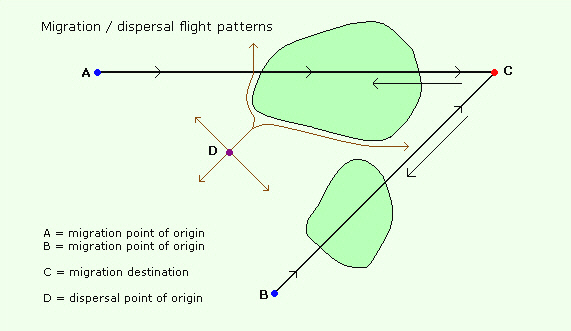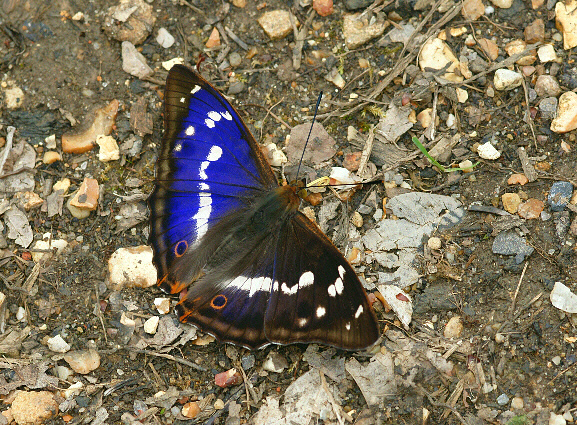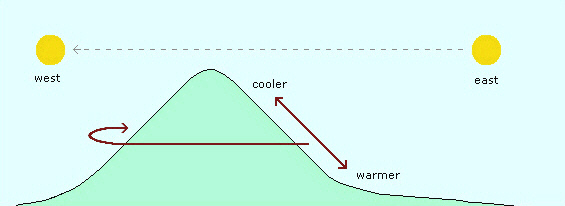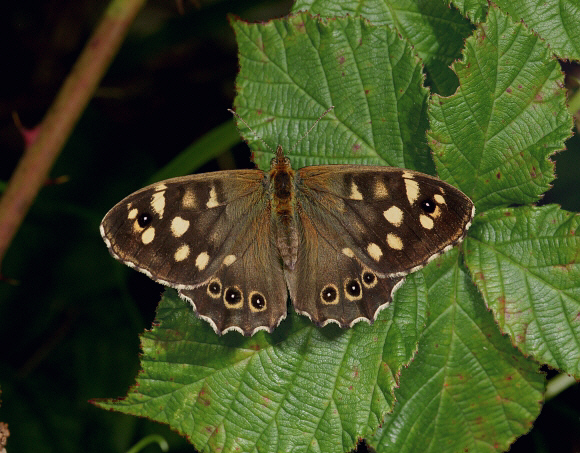It’s possible to find a few butterfly species straying into city parks and gardens, investigating weedy areas of wasteland or flying in other ‘unnatural’ habitats, but despite such apparently cosmopolitan lifestyles butterflies are extremely choosy about where they lay their eggs.
Butterflies have strict requirements in terms of minimum / maximum temperature tolerance. The habitats they occupy are determined by where their larval foodplants grow, and by the availability of adult food sources and roosting sites. They are unable to survive and breed unless these and numerous other vital conditions are precisely met. Suitable habitats are often highly localised so consequently many species have an extremely patchy distribution.
Most species never stray more than a kilometre away from their established breeding grounds – it would be wasteful of their short lives to ramble across barren habitats where there were no suitable plants on which to lay their eggs. Nevertheless all species whether humans or butterflies are to a greater or lesser extent genetically programmed to ‘leave home’, dispersing to explore new areas.
Migration or dispersal ?
It is important to understand the difference between dispersal and migration. The term dispersal is used to describe random and aimless movement away from the site where a butterfly emerges. Dispersing butterflies are easily diverted from their course by minor changes in wind direction or obstacles in their path. They will for example fly around the edge of a block of forest rather than fly through it or over it. When they encounter hostile habitats such as arable farmland, lakes, rivers, roads or buildings they steer left or right to try to find a route around them.
The term migration refers specifically to medium or long distance directional movements. Migrating butterflies have a strong purposeful flight and are unaffected by obstacles or hostile landscapes. If e.g. they encounter a building they will fly over it rather than take an easier route around it. Their flight path is not affected by wind:- C.B.Williams analysed 470 Vanessa cardui migrations in various parts of the world and found no correlation between flight direction and wind direction. Other studies involving migrations of Catopsilia florella and Eurema hecabe in Africa, Pieris brassicae in England and Ascia monuste in North America have arrived at the same conclusion.
Migrations usually involve mass movements – a flight of Vanessa cardui in California in 1924 was estimated to contain about 3000 million butterflies. It has been estimated that a swarm of migrating Libytheana carinenta in Texas in 1921 was passing at a rate of over a million butterflies per minute across a 250 mile wide front. Migrations often begin spontaneously across a wide area, but once in the air the insects all head towards a common destination. It is generally accepted that migration is a 2-way process e.g. butterflies migrating south in autumn will return north again in the spring. In some cases an individual butterfly will take part in both legs of the journey, but in many species a ‘parent’ generation flies in one direction, and it is the offspring that undertake the return journey.

The diagram above illustrates the differences between dispersal and migrational flight patterns. The blocks of green represent ‘hostile’ habitats, e.g. a dispersing grassland butterfly would consider a forest to be hostile so would avoid flying into it or over it. On the other hand a migrant species such as Danaus plexippus, Vanessa cardui or Pieris brassicae would have an extremely directional flight pattern and would fly over a hostile habitat to maintain its compass direction.
Random dispersal
Nothing in nature is constant. Habitats are continually changing. Woodlands become overgrown and shade out herbaceous plants on which the caterpillars of many butterflies depend. Heathlands catch fire, grasslands become overgrown with scrub, deserts expand, cliffs crumble away.
Species at the edge of their natural distribution range tend to inhabit sites which are sheltered from bad weather. Pearl-bordered Fritillaries for example occupy open meadows in mainland Europe, but in Britain such habitats are too cold for them so they form colonies in sheltered woodland clearings instead. Unfortunately these habitats are ephemeral. They fast become overgrown and the violets on which the Fritillary caterpillars feed rapidly get shaded out. Within 2-3 years the habitat can no longer support the species, so the adult butterflies disperse soon after mating, radiating out along forest trails in search of more suitable breeding areas.
Many other factors can trigger dispersion e.g. after a particularly successful breeding season Marsh Fritillary Euphydryas aurinia populations can reach explosive levels. The larvae scour their habitat, devouring every available leaf of their foodplant. Ultimately they sense imminent starvation, and undergo a chemical change which switches them into a high activity phase causing them to swarm across the surrounding countryside in search of food.
Daily Commuting
In Britain adults of Clossiana euphrosyne nectar almost exclusively on bugle – Ajuga reptans. They lay their eggs on dead bracken or dry grass stems, but their caterpillars feed on Viola. Fortunately for the butterfly all of these plants can be found in the same habitat – recently cleared woodland, so it is here that the butterflies spend their entire lives.
Many other species however are not so lucky – their larval foodplants may grow in entirely different places from the adult food sources, so they need to commute between breeding and feeding sites.
Species such as Apatura iris which occur at low density in woodland habitats can’t easily locate the opposite sex, so they have evolved ‘hill-topping’ – a strategy whereby both sexes fly to the highest point in the vicinity, typically a tall oak tree on a ridge, where courtship and copulation take place. After mating the females disperse to lay their eggs on sallow bushes which typically grow alongside ditches on lower ground. The males also disperse to low lying areas where they feed by imbibing mineralised moisture from the paths or patches of mud. Next morning they commute back to the ‘master’ oak tree to mate with other females.

Purple Emperor Apatura iris commutes daily between feeding and courtship sites – Adrian Hoskins
Montane butterflies
In temperate regions mountainous areas such as the Alps, Pyrenees, Rockies and Tien Shan, land above about 1800m is covered in snow for much of the year. In the Andes, the Himalaya and the mountain ranges of New Guinea areas as low as 3000m are subject to seasonal snow cover. During the short montane summer however, the meadows and pastures become carpeted in vast swathes of flowers, attended by hordes of butterflies.
Swarms of Blues, Fritillaries and Skippers aggregate to imbibe moisture from patches of mud; while Coppers, Ringlets, Apollos and Heaths nectar avidly at the abundant flowers. Most of these species are sedentary insects, forming highly localised breeding colonies. Because they are ‘stay-at-home’ species, their flight season is limited to 2-3 weeks in mid-summer, and they have to spend several months of their lives hibernating as either eggs or caterpillars.
Other species such as Clouded Yellows, Whites and Swallowtails are nomadic, and migrate down to the lowlands in late summer to breed. In the early spring their progeny produce a further brood in the lowlands, but the habitat there becomes too hot and dry in summer, so they then return to the mountainsides where there is cooler air and an abundance of flowers for nectaring.
Another form of altitudinal movement takes place on a daily basis. In alpine regions one side of a mountain may remain in the shade until late morning. Sunlight reaches the east facing slopes first, but may not reach steep west facing slopes until late afternoon. Consequently butterflies commute around the mountainsides to keep pace with the sun.
Butterflies commute altitudinally too, moving from peaks to valleys and back again, to areas where the temperature is most suitable. Sometimes these journeys take them to mountain passes. Over the millennia these become established routes by which species migrate seasonally from one valley to another.

Seasonal migration
Seasonal migration is an entirely different phenomenon from commuting or random dispersal. It tends to occur spontaneously and involves the mass movement of hundreds, thousands or even millions of butterflies.
The evolution of migratory behaviour
When butterflies first evolved the present day continents were united to form the giant land mass Pangaea. In the centre of such a massive continent there would have been huge seasonal extremes of temperature and humidity. Consequently butterflies would have had to find some way to survive when their larval foodplants and nectar sources wilted in summer, or when temperatures were too high or too low for normal activity.
One choice would be to remain in situ and diapause, i.e. to aestivate. In a diapaused state large numbers would perish due to predation by insectivorous birds. A better alternative would be to fly to another location e.g. close to a river, where foodplants would continue to be available long after the surrounding land had dried out. Further foodplants would then be found by migrating up or down river. Natural selection would ensure that butterflies which survived as a result of such migratory actions would be able to pass on the trait genetically. It is perhaps no coincidence that so many species in the tropics still use rivers and streams as migration paths.
In subsequent geological periods the migratory behaviour would have been interrupted as tectonic activity caused mountain ranges and seas to appear, thereby splitting up formerly contiguous areas of breeding terrain. These geological movements took place over millions of years, during which butterflies probably continued to migrate along the same routes, crossing mountain ranges via low passes, and hopping from island to island to cross seas and oceans.
Many species would have been unable to overcome the new natural barriers, particularly the ever widening oceans. Their populations therefore became permanently divided, gradually taking on new characteristics, and ultimately evolving into new species. Other species however managed to cross the barriers regularly, and migratory behaviour became genetically imprinted in them.
Migration triggers
Individual migrations appear to be triggered primarily by climatic phenomena, often in association with over-abundance, and depletion of larval food resources.
C.B.Williams in his book ‘Insect Migration’ quotes Skertchley, who in March 1869 witnessed the commencement of a migration of Vanessa cardui in desert behind Suakin by the Red Sea :
“He noticed that the whole mass of grass, through which they were riding on camels, was in a state of violent agitation although there was no wind. When he dismounted he found that the cause was the emergence from the chrysalis of myriads of Painted Lady butterflies, which dried their wings and about half an hour later flew off together eastwards towards the sea”.
Often climatic differences on opposite sides of a mountain range will cause butterflies to migrate between them, ascending to cross over high alpine passes. Beebe’s observations include accounts of over 250 butterfly species migrating through the 1000m high Portacheulo Pass in Venezuela. 22 of these species were said to have occurred in “thousands”. In late May 1946 he and 4 colleagues used stop watches and counters to try to estimate the numbers of Eunica monima migrating through the pass. In Beebe’s own words they “completely failed to keep up with fast enough estimates of numbers, but at a minimum clocked 1000 per second going past in the face of a gentle breeze”.
Route-finding
Research on Monarchs has shown that their annual migration from Canada to Mexico is controlled by a ‘time-compensated sun compass’ that depends on light receptors, and a circadian clock built into the antennae. When scientists removed the antennae from one group of Monarchs they flew strongly but in random directions, but a control group with their antennae intact all flew in the same direction – their south-westerly migration route. In another experiment the antennae of some were painted with black enamel, and these butterflies when placed in a flight simulator all flew together, but in the ‘wrong’ direction compared to their normal migration route. Another group had their antennae painted with transparent paint, and these all migrated together in the right direction.
| The circadian clock employs rhythms of biochemical, physiological or behavioural processes that control time based behaviour including the daily mate location / rest / feeding cycle of males and the oviposition / rest / feeding cycle of females. The clock also triggers one-off activities such as emergence, and annual / seasonal activities including migration. The precise timings are modified by climatic factors such as temperature, humidity and sunlight levels. |
Research by Chapman suggests that migratory butterflies and other insects are programmed to seek out ‘wind highways’ in the sky, which they use to enable them to travel quickly during their migratory flights. This may be the case with certain species, but it is well documented that species including Colias crocea, Vanessa cardui and Pieris rapae fly very low over the sea when migrating from the European mainland to Britain. There is for example a famous account by Rev. Harrison, who in 1868, from a cliff near Marazion, Cornwall, observed “a yellow patch out at sea, which as it came nearer showed itself to be composed of thousands of Clouded Yellows, which approached flying close over the water, rising and falling over every wave till they reached the cliffs”.
A team of neurobiologists led by Steven Reppert of the University of Massachusetts spent several years investigating Monarchs. In 2010 they published a paper indicationg that they had discovered that Monarchs have 2 types of photoreceptor proteins which not only allow them to see UV light but also enable them to detect the Earth’s magnetic field. A series of experiments on Drosophila fruit flies whose genomes were engineered using Monarch Cry1 and Cry2 cryptochrome proteins proved that they respond to magnetic fields when under the influence of UV-A/blue light.
Expansion and contraction of range
The overall area in which a species can be found is called its range. Within that range there will be areas of unsuitable habitat so the distribution within a butterfly’s range is always patchy. The range and distribution are limited by climate, geology, aspect and altitude, all of which affect the type of larval foodplants and adult nectar sources that will grow in an area.
The distribution of a species within its range is also greatly affected by human intervention – urban expansion has the greatest impact, but governmental policy on farming, forestry and road planning also has a very profound effect on the distribution and abundance of butterflies.
An example is the High Brown Fritillary Argynnis adippe which was widely distributed and common in England until the 1950’s. It’s range then contracted rapidly as a result of habitat fragmentation, and a change from traditional coppice woodland management to the mass planting of conifers in English forests. By the turn of the 21st century the butterfly had disappeared from virtually all of its former habitats. Now in 2012 it clings to its existence at just a handful of sites in western England.
Most other forest butterflies have also declined as a result of being shaded out of the darker and cooler modern woodlands. Only one British species Pararge aegeria has benefited, as it survives better in shadier conditions. It has even been able to increase it’s formerly patchy distribution in the UK to the point where it is currently widespread and common over almost its entire range.

Speckled Wood Pararge aegeria, a species expanding its range – Adrian Hoskins
